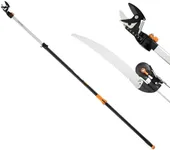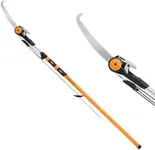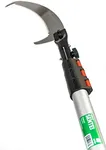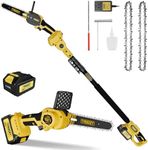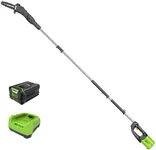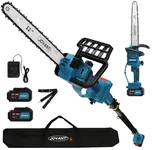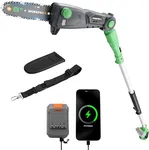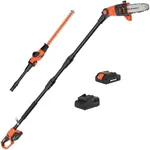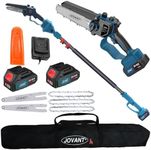Buying Guide for the Best Pole Saw Pruner
Choosing the right pole saw pruner can make your gardening tasks much easier and more efficient. A pole saw pruner is a tool designed to help you trim and prune branches that are out of reach without the need for a ladder. To find the best fit for you, it's important to consider several key specifications that will determine the tool's performance and suitability for your needs.Power SourceThe power source of a pole saw pruner can be either gas, electric (corded), or battery (cordless). Gas-powered models are typically the most powerful and are suitable for heavy-duty tasks and large properties. However, they are also heavier and noisier. Electric corded models are lighter and quieter, making them ideal for smaller yards, but they require access to an electrical outlet and may limit your range. Battery-powered models offer a good balance of power and convenience, with the added benefit of portability, but their runtime is limited by battery life. Choose based on the size of your yard and the type of tasks you need to perform.
Bar LengthThe bar length of a pole saw pruner refers to the length of the cutting blade. This is important because it determines the maximum diameter of branches you can cut. Bar lengths typically range from 6 to 12 inches. Shorter bars (6-8 inches) are suitable for light pruning and smaller branches, while longer bars (10-12 inches) are better for thicker branches and more demanding tasks. Consider the types of branches you will be cutting most often to choose the appropriate bar length.
Pole LengthThe pole length determines how high you can reach with the saw. Pole saw pruners usually have adjustable poles that can extend to different lengths, typically ranging from 8 to 15 feet. A longer pole allows you to reach higher branches without a ladder, but it can also make the tool harder to control. If you have tall trees or need to reach high branches, opt for a longer pole. For lower branches and better maneuverability, a shorter pole may be more suitable.
WeightThe weight of the pole saw pruner affects how easy it is to handle and use for extended periods. Heavier models can be more tiring to use, especially when working overhead. Lighter models are easier to maneuver and less fatiguing, but they may not be as powerful. Consider your physical strength and the duration of your typical pruning tasks when choosing the weight of the tool.
Cutting CapacityCutting capacity refers to the maximum diameter of branches that the pole saw pruner can cut. This is usually determined by the bar length and the power of the saw. A higher cutting capacity is important if you need to cut thicker branches. For light pruning and smaller branches, a lower cutting capacity will suffice. Assess the size of the branches you will be cutting to determine the necessary cutting capacity.
Ease of UseEase of use encompasses several factors, including the weight, balance, and ergonomics of the pole saw pruner. Look for features such as a comfortable grip, easy-to-use controls, and a well-balanced design. These features can make a significant difference in reducing fatigue and improving the overall user experience. If possible, try handling the tool before purchasing to ensure it feels comfortable and manageable.
MaintenanceMaintenance requirements can vary between different types of pole saw pruners. Gas-powered models typically require more maintenance, such as fuel mixing, engine cleaning, and regular tune-ups. Electric and battery-powered models generally require less maintenance, but you will need to keep the chain sharp and properly tensioned. Consider how much time and effort you are willing to invest in maintaining your tool when making your choice.

